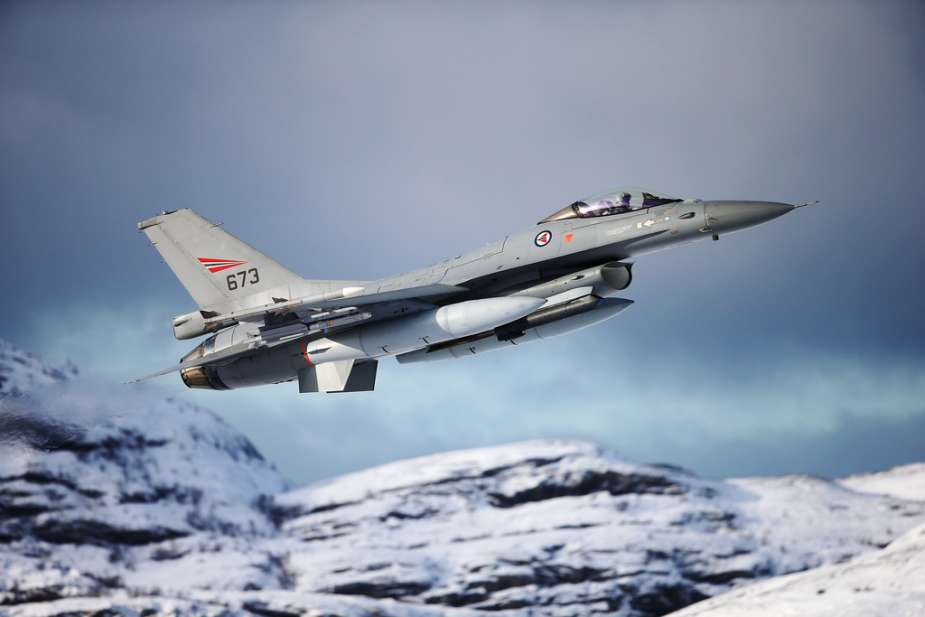On April 11, 2024, Ilia Yevlash, the spokesman for the Air Force of Ukraine, provided updates on the training of Ukrainian pilots for F-16 fighter jets. This training has taken place in Denmark and the USA, focusing on tasks such as targeting Shahed UAVs, such as the Shahed-136 and the Shahed-238, and intercepting rockets. According to Yevlash, this final stage also involves practicing precision strikes on small targets.
Follow Army Recognition on Google News at this link

The F-16 training coalition, comprising 11 NATO countries including Denmark and Norway, was established at the NATO summit in Vilnius on July 11, 2023, to assist Ukraine's Air Force. (Picture source: Norway MoD)
Additionally, there are ongoing English language courses for pilots in Great Britain and another group is in France learning to operate light aircraft control systems using Alpha Jets. The training program also includes Ukrainian technical personnel who, upon their return, will be responsible for educating their peers in Ukraine.
While an F-16 could technically intercept a Shahed-136 drone, the relatively inexpensive and expendable nature of drones like the Shahed-136 poses a unique challenge that might not justify the use of high-value fighter jets for interception. Ate Chuet has pointed out that while Western armies may achieve a drone interception rate close to 98% against low-cost drones like the Shahed-type, such performance levels are not sustainable long-term. These interception systems can operate at full capacity for only about 2 or 3 days before needing to recharge or undergo maintenance. Additionally, the cost of using sophisticated fighters and missiles for drone interception is substantially higher compared to the production cost of a Shahed-type drone, raising concerns about the long-term feasibility of such interception strategies.
Less expensive alternatives, such as ground-based anti-aircraft systems such as the Viktor MR-2, or electronic warfare systems to interfere with their control signals, have been effectively employed in Ukraine. However, the announced training exercises might be similar to the Israeli Air Force's use of the Delta-wing RS2, a replica of the Shahed 136 drone, for training exercises within their "Red Squadron" to simulate enemy tactics, as the Shahed-136 is a low-speed, low-altitude kamikaze drone that can be difficult to detect and track due to its small size and operational tactics.
The process of transferring F-16 jets to Ukraine is still under negotiation, with details being discussed confidentially by the involved parties. Despite this, there has been progress in the international support for Ukraine’s air capabilities. Norway, for example, has been authorized by the United States to transfer 22 F-16 jets to Ukraine on April 11, 2024. This initiative is part of a larger agreement with the Netherlands and Denmark to supply a total of 65 F-16s to Ukraine.
The acquisition of these F-16 fighters marks a significant upgrade from Ukraine’s older Soviet-era aircraft. Lars Peder Haga, an associate professor at the Norwegian Air Force School, mentioned the strategic importance of these jets for Ukraine's defense, emphasizing that their effectiveness will depend on the appropriate integration of weapon systems and the training of Ukrainian personnel.
In terms of financial support, Belgium has committed 100 million euros to assist Ukraine with the maintenance and support of F-16 fighters. This aid is part of a broader effort to enhance Ukraine's defensive capabilities, which includes an F-16 training coalition, comprising 11 NATO countries led by Denmark and the Netherlands, which was formally established at the NATO summit in Vilnius on July 11, 2023. Aims to train Ukrainian pilots in operating F-16 jets, with Denmark hosting initial training sessions before transitioning to a permanent facility in Romania. The training includes not only pilots but also technicians and support staff, ensuring comprehensive readiness for the operation and maintenance of F-16 Fighting Falcon fighter jets. Furthermore, the Portugal Air Force has stated that the training of Ukrainian military technicians for the maintenance of the F-16 Fighting Falcon fighter jets is scheduled to start in May 2024 and conclude in March 2025.
The F-16 Fighting Falcon, developed by General Dynamics for the U.S. Air Force, is a multirole jet fighter that has transitioned from an air superiority day fighter to performing varied roles in all weather conditions. Since its initial production in 1976, over 4,600 units have been manufactured. The aircraft is equipped for both air-to-air and air-to-surface combat. It features a frameless bubble canopy for increased pilot visibility, a side-mounted control stick to aid maneuverability, and a reclined seat designed to lessen the effects of g-forces. The F-16 also includes design elements aimed at reducing its radar profile and is outfitted with advanced avionics systems that support various weapons and equipment. This includes air-to-air missiles like the AIM-120, which can be used to intercept enemy missiles and drones.
In operational terms, the F-16 is used for tactical air support, suppression of enemy air defenses, reconnaissance, and electronic warfare. It employs the AN/APG-68 radar system, which enhances detection and tracking capabilities, enabling engagement with multiple targets simultaneously. The agility and performance of the F-16 are supported by a high-performance turbofan engine, facilitating both offensive and defensive maneuvers in combat. Continuous upgrades have ensured that the F-16 remains compatible with current air force requirements globally.
















